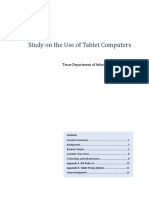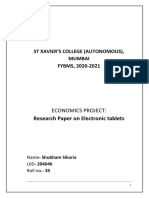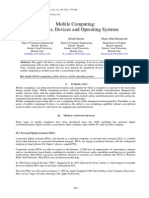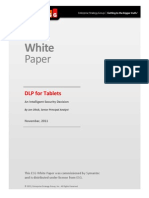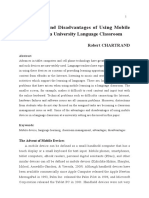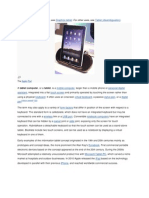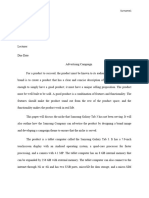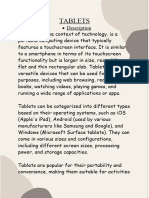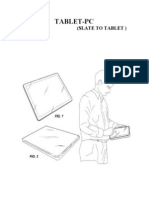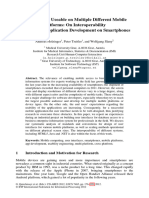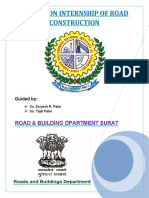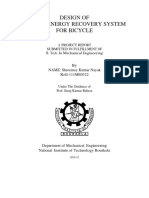THE RAPID DEVELOPMENT OF TABLET COMPUTING
A white paper for TCO Development by Andrew Bibby
v3.0, 17 October 2011 Andrew Bibby
�Introduction
The future will be crawling with tablets. The success of Apples iPad has convinced the world that a slim rectangle with a touch screen is tomorrows computer. So began an article in the Financial Times daily Lex column in September 2011 1. The article went on to note the five-fold increase in the number of tablets sold worldwide between the second quarter of 2010 and the equivalent quarter of 2011. The IT world is all too familiar with hype. Each time a new product or operating system is launched, industry pundits and media commentators reach in their dictionaries for the hyperboles. This is the big one, or so the story goes and then, too often, todays launch turns into tomorrows forgotten product. With tablets, though, there is reason to believe that the industry and media excitement may not be entirely out of place. In the very short period since Apple launched its first iPad in early 2010, the numbers of tablets shipped and sold has grown astonishingly fast. For Apple itself, the iPad has been its fastest-selling product ever. The speed at which tablet computing has taken off brings the risk, though, that some IT brands may rush to bring products to market, in the process skimping on quality and on other key product criteria. The challenge both for those professionals responsible for procuring IT equipment and for end users is to know how to identify those tablets which do meet high standards. The decision by TCO Development to extend its international certification programme to tablets is, therefore, a timely one. This white paper, commissioned from the independent journalist and writer Andrew Bibby, is being published to coincide with the launch of the TCO Certified Tablets programme. The report offers a short examination of the background to the rapid growth of interest in tablet computing, and assesses the wider implications of a technological tool which could change profoundly the future shape of both business and consumer computer usage.
�The growth of a market
Apple launched its iPad on January 27 th 2010 and made it available in Europe, Japan and Australia four months later. On the back of this one product, the tablet market has developed enormously quickly, consistently faster than analysts have predicted. IDC, for example, reported in January 2011 that it expected sales to increase from the 2010 figure of 17 million to 44.6 million in 20112. Three months later, it revised its projection upwards, to around fifty million3. By September 2011, it had again reviewed its forecast, this time to 62.5 million4. It is by no means certain that the final figure for 2011 may not be higher still. Another analyst, Gartner, has suggested likely sales of 69.7 million for the year. It also suggests that in 2012 total sales could be 108 million, reaching almost three hundred million a year by 2015. The table below, produced by Gartner in April 2012, also breaks down these predicted sales by operating system5.
Table 1: Projected sales of media tablets (millions)
2010 iOS (Apple) 14.7 Android 2.5 Other OS 0.3 Total 17.6
Source: Gartner
2011 47.9 13.9 7.9 69.7
2012 68.7 26.4 13.2 108.2
2015 138.5 113.4 42.1 294.1
As the table make clear, Garner anticipates that Apple will continue to dominate the tablet market at least for the next three years, with its market share predicted still to be around 48% in 2015. This is borne out in the graph below, produced by the Financial Times from data supplied by Enders Analysis and Credit Suisse 6.
�Fig 1: Quarterly sales of tablets by operating system
Source: Financial Times, sources Enders Analysis, Credit Suisse
At the same time, prices are expected to fall markedly. In 2010, the global average selling price of a tablet was around USD 600; this is anticipated to fall to around USD 400 by 20157. Tablets are, all in all, set to become an very significant market. But as the Financial Times also points out, it is not the technology itself but how it is used which will increasingly become important: The game becomes how to control, price, and deliver services and content. The actual little rectangle will become an afterthought.8
Two kinds of tablet
Although most commentators tend to discuss tablets as a generic product, it should be borne in mind that there are in fact two distinct categories of tablet those which have been developed from mobile telephones (smartphones) and which use smartphone operating systems such as iOS (Apple) and Android (Google), and those which have come out of notebook and netbook computer technology, and which use full computing operating systems such as Windows 7.
�Because of the current market dominance of Apples iPad, the vast majority of tablets being used at present are based on smartphone operating systems. These are what some commentators describe as media tablets, contrasting these with what they call tablet PCs. Interestingly, some IT brands are choosing to enter the tablet market from both directions; examples are Samsung and Lenovo, both of which currently have both types of tablet product available. For the end-user, there can be advantages and disadvantages with both types of tablet. Tablets with smartphone operating systems typically demand less processing power and therefore are less power- and energy-hungry. They are likely to be easy to navigate, using finger-touch technologies, and can offer access to the growing store of Apple and Android apps. On the other hand, those tablets which come from the notebook/netbook tradition, whilst requiring more processing power and energy, are more suited for the creation of content. A business user wanting to develop or edit a PowerPoint presentation or write a report in Word, for example, will be able to do so with almost as much ease as on a notebook computer particularly if an external keyboard can also be connected. It may be noted that TCO Developments certification programme for tablets has been designed to be able to suit both these types of tablet. TCO Development s own definition of a tablet is that of a complete mobile computer, larger than a mobile phone integrated into a flat touch screen and primarily touch screen operated, (using) an onscreen virtual keyboard or a digital pen instead of a physical keyboard. TCO Developments criteria applies to all display sizes above 4 inches, and also excludes mobile phone devices which are designed to be held against the ear. This might be the place to add that a further distinction can be made between tablets and e-readers such as Amazons Kindle, marketed initially simply as an electronic alternative to a traditional printed book. Dedicated e-readers such as Kindle have also taken off rapidly over the past twelve months, and whilst a traditional Kindle does not meet the complete mobile computer requirement nevertheless the trend is towards a growing convergence between tablets and ereaders. The launch in late 2011 by Amazon of its new Kindle Fire is an indication of this development.9
�Tablets and the business user
Businesses as well as consumers have been quick to identify the possible uses of the tablet computer in the work environment. Useful surveys of business tablet use have been conducted in the US by ChangeWave Research, both in 2010 and again in August 2011. Its 2011 survey points to the continued market dominance of Apple for tablets for business use.10
Fig 3: Corporate tablet demand
Source: ChangeWave Research
ChangeWave explored the usages which business is making of the tablet in its 2010 survey of 1641 business IT buyers, reporting that the most popular use was, predictably enough, for internet and email access. Beyond this, ChangeWave found that 46% of those with tablets at work used them to provide sales support, and 45% used them for sales presentations. IT analysts Gartner have been particularly enthusiastic about the use of tablets in business, as reflected in the title of their briefing note CEO Advisory: Seize the iPad Opportunity Now in September 201011. More recently, its research vicepresident David Willis has talked of tablets enormous potential in the workplace: They can be a convenient replacement for tasks where a notebook seemed to be the only option (eg reading and otherwise consuming data). They can also serve as data entry devices for short tasks where a smartphone is too small, such as simple forms entry. Another interesting set of uses centers around tablets
�permanently mounted in a physical location, such as a kiosk, vehicle or elevator. 12 Like ChangeWave, Willis identifies the value of tablets for sales staff: Many sales leaders are clamouring to adopt them in their workforce. And it wont stop there: next will come customer relationship management systems, order entry and sales configuration applications. For sales managers, media tablets will be a natural platform for business analytics and performance dashboards, he writes. There are however clearly limitations at present to business use, particularly with tablets using smartphone-based operating systems as opposed to full PC operating systems. One IT journalist has pointed out the problems users encounter in creating presentations on iPads: Unless they make presentations on a PC and import them into their iPad which gives less than satisfactory results creating anything other than a one- or two-slide presentation must be a labor of love.13 We need to recall that tablets are still an emerging technology.
Issues around usability
New technology of any kind can raise questions of usability and health and safety concerns. The issue is particularly pertinent as business use of tablets increases, given companies responsibility for the occupational safety and health of their employees. Right from the start, tablet computers have attracted a very strong positive response from users. Not everyone however has always been entirely complimentary: for example, the problem of reading tablet screens in bright light was raised by the Financial Times technology writer Alan Cane, who complained of the potential problems of using tablets in the open air in bright sunlight.14 Rather more caustically, one cynical blogger commented shortly after the first iPad launch: Would love to know what percentage of iPad users will get RSI [repetitive strain injury] and degraded eyesight in the next few years. 15 Because the display is so central to the experience of using a tablet (a tablet is, fundamentally, simply a display linked to processing power), the precise attributes of the display technology take on an especial significance. The physicist and technology analyst Raymond Soneira has looked in detail at the screen technology of five tablets and has drawn attention to a number of ways in which current tablet displays can be improved and made more user-friendly. As he reports, Firstly all
�of these Tablets have large shiny mirror-like screens actually a very bad feature that requires higher screen brightness and more battery power to offset the reflected light, and it also causes eye strain. The larger Tablet screen size makes it harder to position both yourself and the screen to avoid bright reflections. Second: all of these Tablets have a reduced Color Gamut that produces images with less saturated colors. Its an intentional tradeoff made to increase screen brightness, power efficiency and battery run time. Third: all of these Tablets have a sharp decrease in Brightness and Contract with Viewing Angle. This is a significant issue only when multiple viewers are watching a Tablet but may also require a single viewer to carefully adjust the Tablet orientation. Fourth: all of these Tablets have an unsatisfactory Ambient Light Sensor and Automatic Brightness Control, which wastes battery power and causes eye strain.16 Soneira was writing in mid-2011, and we can expect that tablet manufacturers and brands are already addressing some of these concerns. The task of ensuring that tablet users do have a product which meets their legitimate expectations in terms of usability is obviously very important. Experience with previous computer technologies suggests that external assessment and certification helps IT procurement professionals and end-users when they are faced with selecting between apparently similar products, and also helps more generally in raising overall standards across the industry. The final sections of this white paper offer a brief resume of the approach the TCO Certified Tablet programme is taking.
Raising standards: the TCO Certified Tablets programme
The decision by TCO Development to offer the new Certified Tablets programme introduces what is the first independent certification available for the tablet market. As with other TCO Certified products, the criteria in TCO Certified Tablets focuses on performance, environmental design and energy efficiency, and corporate social responsibility. The story of the certification of IT products by TCO goes back to the early days of mass computing. The first certification programme, TCO92, was developed by the Swedish professional trade union federation in the late 1980s and early 1990s and launched, as the name suggests, in 1992. The TCO 92 standard assessed visual display screens based on emitted radiation, energy efficiency and electrical safety,
�and the TCO92 label, fixed to IT monitors, rapidly became a familiar sight around the world. The TCO certification was toughened three years later for the TCO95 programme with its focus on the four Es (ecology, energy, ergonomics and emissions), and then developed further, firstly with TCO99, then in a series of initiatives from 2001-2007,and finally with the launch of the generic TCO Certified programme in 2009. At the same time TCO Development gradually extended the scope of its certification to include desktop PCs, notebooks, all-in-one computers, projectors and headsets. It points out that more than seventy IT brands and manufacturers have sought and successfully obtained certification, including such well-known companies as LG, Lenovo, Dell, HP, Samsung, Plantronics and NEC. TCO Development uses a network of independent laboratories around the world to ensure that the criteria it establishes are met. Given TCO Developments early history in relation to display screens, it is appropriate that it has turned its attention now to the qualities of tablet displays. Because of the significance of the display for the usability of tablets, TCO Development has in fact imposed tougher visual ergonomics and performance criteria on tablets compared with those used for certification for other products. As it argues, Good visual ergonomics is a very important aspect of quality that can also have a direct effect on the health, comfort and performance of the user17. Five criteria are covered in relation to the display: image detail, luminance, luminance contrast, reflection, and colour performance. Broader ergonomic issues are covered as well, including the ability where appropriate to connect external devices such as keyboards and larger display screens.
Addressing the environmental issues
As with the TCO Certified programmes for other products, TCO Development not only considers issues of usability and occupational safety and health when assessing tablet performance. It also imposes certification criteria addressing issues of environmental and social responsibility, what it calls the other two pillars of its certification approach. In one respect, the astonishing growth in tablet sales mentioned earlier in this report could be seen not as cause for celebration but as cause for concern. If over a hundred million tablets are to be sold during the twelve months of 2012, as 9
�Gartner suggests, this represents a further avalanche of technology products into a world which is already full of other computing equipment and gadgetry. It represents further demand for the raw materials, some of them scarce, which go into the manufacturing process and into such components as the batteries. It also means that yet more electrical devices will be using energy. The prospect is, regrettably, that as with PCs and notebooks, many tablets will be left on tricklecharge, drawing power unnecessarily and contributing indirectly to increased carbon emissions. Every tablet manufactured and sold will also, at some point, need to be disposed of. It is only relatively recently (helped by initiatives such as the European Unions Waste Electrical and Electronic Equipment Directive of 2002) that the IT industry has been required to begin to face up to its responsibilities in this respect, and there remains a long way to go before a full life-cycle approach to IT products is central to all manufacturers and brands thinking.
The criteria for the Certified Tablet programme cover each of these environmental concerns, adopting a whole-of-life perspective to tablet manufacture and disposal. As TCO Development puts it, potential environmental effects are evident at each stage of the product life cycleThe environmental requirements TCO Development has focused on are those that we consider most relevant to the product group. They have also proved to be attainable in volume production and are verifiable.18 What this means in practice is that the environmental requirements of the Certified Tablet programme are divided into six categories. The first of these covers organisation during the production phase (including a requirement for environmental management system certification). Secondly, there is a focus on climate change issues, centred on the energy consumption of tablets. A third focus is on the use of hazardous substances. TCO Development has long taken a lead in encouraging manufacturers to move towards eliminating the use of heavy
10
�metals such as lead, mercury, cadmium and chromium, and the Certified Tablet programme continues this initiative. For example, under TCO Development certification, mercury is required to be entirely absent from products. A fourth focus is on the product lifetime. As TCO Development explains, A longer product lifetime has a significant positive contribution to resource use as well as the reduction of air and water pollution. A pre-condition for prolonged lifetime is that the product is of high quality, which is supported by good guarantees. Another requirement is the availability of spare parts for the product once it is taken out of production.19 Finally, the Certified Tablet programme also imposes requirement for packaging and for preparation for recycling.
Addressing the social issues
Since the launch of the TCO Certified programme in 2009, TCO Development has been addressing issues in relation to social responsibility in its certification work. This new and important development reflects the growing interest and concern by IT procurement professionals and end-users in this aspect of the products they are buying. As is well known, the IT industry comprises both the IT brands and the actual product manufacturers, usually located in China and other east Asian countries. Recent years have seen some worrying stories of poor labour conditions in certain electronics plants. The Financial Times reported in 2010, for example, that a spate of suicides among workers at the worlds largest electronics contract manufacturer is fuelling debate internally and abroad. The story was about Foxconn, whose clients include Apple, Dell and HP and which operates a vast factory town in Shenzen, southern China.20 At the other end of the product lifecycle, there have been equally worrying stories of very poor working conditions related to handling of electronic waste from developed countries which has been exported to developing countries. This has also been widely covered by the media. Once again the Financial Times is among those covering the story, reporting in early 2011: The [UK] Environment Agency is pursing thirty cases, most of which involve electrical waste that has been sold
11
�illegally to west Africa Once they arrive in Nigeria or Ghana, the waste is burnt to remove the plastic while workers, including children, scramble through the remains to pick out useful metals such as copper. They are exposed to harmful substances such as cadmium and mercury while working in the toxic fumes. 21 Whilst many companies today seek to promote themselves as models of corporate social responsibility, the term by itself can be little more than an attempt to gain positive PR from token efforts. There are, however, a number of independent global initiatives in the field of social responsibility which impose somewhat more rigorous standards, to which companies can sign up. TCO Development at this stage in its developing work around social responsibility has linked certification with compliance with one of four internationally recognised initiatives. The first is the Global Compact, launched by the UN Secretary-General in 1999; it lays down ten principles by which companies wishing to sign up to the Compact are required to uphold. These include support for internationally proclaimed human right. and compliance with core labour standards (core labour standards, established by the UN agency the International Labour Organization as part of its call for decent work, include recognition of freedom of association and collective representation, the effective abolition of child labour, the elimination of forced labour and the ending of discrimination in the workplace). The UN does not monitor companies embracing the Global Compact for compliance, but companies are expected to publish in a report each year the details of how they are meeting these principles. Another venture, the Global Reporting Initiative, offers a standard way for companies to report on their record on human rights, labour rights, social issues, environmental and economic achievements, using a set of 79 performance indicators. There are different GRI standards; the TCO Certified programme requires a company to meet GRI G3 level C or higher. SA8000 is a well-known global social accountability standard for decent working conditions, overseen by Social Accountability International. SA8000 is based on the Universal Declaration of Human Rights, the UN Convention on the Rights of the Child, and International Labour Organization core labour standards. TCO Development accepts a valid SA8000 certificate as evidence of compliance. TCO Development also recognises for certification purposes those companies which are active members of the Electronic Industry Citizenship Coalition (EICC), an industry group working to ensure credible implementation of the Electronic 12
�Industry Code of Conduct. Finally, TCO Development will consider evidence that companies are undertaking their own CSR initiative equivalent to one or more of these four schemes.
Conclusion
Tablets are a phenomenon, one of those products we didnt know we needed until the iPad arrived but which many of us now feel we couldnt do without. Brands and manufacturers have geared up rapidly to meet the demand. Box after box after box is being shipped; warehouses and retail outlets are piled high, ready for the customers. Book publishers and media companies with paper-based newspapers and magazines are among those taking a very keen interest in the new market opportunities. As the range of tablet products increases, so does the difficulty of choosing between brands. It is helpful, therefore, that tablets have now been brought within the scope of the TCO Certified programme. The global recognition of TCO Developments certification programme offers useful reassurance that IT products are well designed not only both for the benefit of the user but also in relation to broader social and environmental factors.
13
�1 2
Lex, Tablet computers: come round to my pad, Financial Times, September 8 2011 IDC, IDCs Worldwide Quarterly Media Tablet and eReader Tracker Makes Its Debut, Projects Nearly 17 Million Media Tablets Shipped Worldwide in 2010, January 18 2011 3 IDC, Nearly 18 Million Media Tablets Shipped in 2010 with Apple Capturing 83% Share; eReader Shipments Quadrupled to More than 12 Million, According to IDC, March 10 1011 4 IDC, Media Tablet and eReader Markets Beat Second Quarter Targets, Forecast Increased for 2011, According to IDC, September 14 2011 5 Gartner Says Apple iOS to Dominate the Media Tablet Market Through 2015, Owning More Than Half of It for the Next Three Years, April 11 2011 6 Lex, Tablet computers: come round to my pad, Financial Times, September 8 2011 7 ibid 8 ibid 9 Richard Waters and Chris Nuttall, Amazon breathes Fire into tablet market, Financial Times, September 30 2011 10 ChangeWave Research, Corporate Demand Outlook 2011 11 http://www.gartner.com 12 David A Willis, iPad and Beyond: The Media Tablet in Business, Gartner, March 15 2011 13 Keir Thomas, How useful are talets for business?, PC World, January 10 2011, http://www.pcworld.com/businesscenter/article/216376/how_useful_are_tablets_for_business.htm 14 see for example Alan Cane, Perspectives: will tarsiers inherit the earth?, Financial Times, September 20 2011 15 www.techradar.com/news/computing/apple/ipad-users-prefer-screens-to-printed-books-710232 16 Raymond Soneira, Tablet display technology shoot-out, Veritas and Visus July 2011; http://www.displaymate.com/Tablet_ShootOut_2.htm 17 TCO, TCO Certified Tablets 1.0, September 19 2011 18 ibid 19 ibid 20 Kathrin Hille, Showing the Strain, Financial Times, May 29-20 2010; Robin Kwong, Foxconn to revise factory town model, Financial Times, June 9 2010. 21 Jim Pickard, Probe claims gangs exporting toxic recycling waste to developing world, Financial Times, February 10, 2011
14











